We’ve heard about probiotics for a few years now, but do you know what prebiotics are?
As you might already know, probiotics are living bacteria inside our intestines. They balance our gut and keep our processes running smoothly. Probiotics help protect our immune system and are necessary for gut health.
Like all living organisms, they need food. That’s right! Our probiotic gut bacteria need to eat. And, they need specific foods. This is where prebiotics come in. Prebiotics are food for probiotics. It sounds strange, yet it is a very important part of keeping our gut healthy!
So how do we feed our gut bacteria? Or, what do we feed them? We’ll tell you below all you need to know about prebiotics, such as why your body needs them, what types of foods they are found in, and how they work within the greater system. Furthermore, we’ll show you how easy it is to get them into your daily diet.
Ultimately, we will highlight how our intestines are the base of good health and show you how to attend to your gut health even better than before.
What Are Prebiotics?

In the deep, dark depths of your bowels dwell living organisms that keep you healthy and ensure your bodily systems are running smoothly. These colonies of living gut bacteria are known as probiotics. They are supplemented when you eat probiotic-rich foods such as yogurt, sauerkraut, and kimchi. But these colonies of gut flora need more than just support from each other to keep working. They also need food.
So, how do we provide food for probiotics? Simply by eating prebiotics! Prebiotics are non-digestible fibers that we get from certain foods we eat. These fibers can be found in foods such as onions, garlic, and apple skins. They move through your small intestine undigested before being fermented in your colon. They are then used as food for the probiotic bacteria living in your gut.[1]
The most interesting thing about how our bodies process prebiotics is the selectivity process. Of the thousands of strains of gut bacteria living in our intestines, prebiotic food is selectively fermented inside our gut by our intestinal flora to assist it in its process to protect our health and well-being.[2]
Which types of fiber are prebiotics?

To start, there are eight types of fiber that can be classified as prebiotics. In our gut, they form short-chain fatty acids (SCFA), which probiotics can use as food to maintain our gut health.[3] These prebiotic fibers are:
- Beta-glucan: cereal grains (especially oats and barley), mushrooms, algae, and marine plants.[4]
- Fructo-oligosaccharides (FOS), oligofructose and inulin: Jerusalem artichokes, raw chicory, raw or cooked onion, raw garlic, tomatoes, and underripe bananas.[5]
- Galacto-oligosaccharides (GOS): lentils, chickpeas, hummus, green peas, lima beans, and kidney beans.[6]
- Isomalto-oligosaccharides (IMO): natural starch processed from cereal crops like wheat, barley, pulses (peas, beans, lentils), oats, tapioca, rice, potato, and others.[7]
- Guar gum: natural, plant-based thickener and stabilizer found in cottage cheese and soft cheeses, ice cream, low-fat yogurt, pie fillings, processed breads, ketchup, pickle relish, sausage, and stuffed meat products.[8]
- Lactulose: a man-made supplement that is a medical treatment comprised of two milk sugar components: galactose and glucose.[9]
- Resistant Starches (RS) and maltodextrin: RS is naturally present in certain foods such as unripe bananas, potatoes, grains, pulses, seeds, lentils, peas, and beans.[10] Maltodextrin is a natural starch often used as thickener and sweetener. It is found in canned fruits, snacks, cereals, desserts, instant puddings, sauces and salad dressings, and in Splenda and Equal.[11]
- Xylo-oligosaccharides (XOS) and arabino-oligosaccharides (AOS): XOS is prominent in bamboo shoots, fruits, vegetables, milk, and honey.[12] AOS is in grains like wheat, rye, oats, barley, and maize.[13]
Some of these foods actually cause harmful bacteria to enter into our system. This can be because they are processed foods (like guar gum), are artificial sweeteners (like maltodextrin), or are indigestible due to intolerance (like lactulose).
The Only 3 Prebiotics You Need: FOS, Inulin, and RS

Research shows that by adding 2-3g per day of additional fructo-oligosaccharides (FOS) or inulin can favorably alter the bacteria of the large intestine.[14] Higher doses may also have added health benefits, like helping to lower cholesterol triglycerides and regulating blood glucose in type II diabetics.[15]
In one study, 244 subjects traveling to high to medium-risk destinations were given 10g of inulin per day. The prebiotics reduced the travelers’ prevalence of diarrhea as well as having less severe attacks of it.[16] Even just 5.5g of inulin during the week before traveling prevented the incidence and duration of travelers’ diarrhea.[17] Thus, what these prebiotics can do is help to normalize and control our gut health, even in risky or difficult situations.
Resistant starches (RS) are no different. As a prebiotic, they function the exact same way as FOS and inulin. RS are easily found in unripe bananas, potatoes, grains, pulses, seeds, lentils, peas, and beans. So, it’s actually easy to get enough RS every day.
Women are recommended to consume at least 15g of fiber per day[18] However, many of us fall short of this. Although it takes some encouragement, intention, and planning, you can ensure you get enough fiber to help you reach optimal health.
Fun Fact: Cooled potatoes are highest in RS (4.3g per 100g), followed by cooled and reheated potatoes (3.5g per 100g), and in the last place, potatoes served hot (3.1g per 100g).[19]
Prebiotics vs. Probiotics

It may be easy to confuse prebiotics and probiotics as the same thing, but they actually play very different roles in keeping our gut and bodies healthy.
Prebiotics are indigestible fibers. On the other hand, probiotics are live bacteria that feed on prebiotics for food. Prebiotics are very hardy. They are not affected by heat, your body’s enzymes, or gastric acids. These qualities are what makes them non-digestible. They can be added to any type of food, drink, or substance, and never change form. Conversely, probiotics are very sensitive and can be killed by our body’s enzymes, gastric acids, or other bacteria that are in our body.
How Taking Them Leads to Better Gut Health
Prebiotics take many different forms and, as such, offer many different health benefits. Because they are mostly fiber, they are great for our intestinal health. They also help with issues related to obesity, heart disease, cholesterol, diabetes, and other health conditions. Due to their notable benefits for our gut health, prebiotics have a growing fan base among the scientific community.
Reduces inflammation
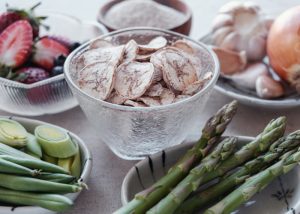
Eating prebiotics changes our gut flora to become more protective of our body. Thus, it alters our immune responses by making them better and by providing balance to our gut health.[20] Many studies have been conducted regarding prebiotics and their effects on chronic intestinal inflammation. These studies show that patients with Crohn’s disease, irritable bowel syndrome or inflammatory bowel disease can eat prebiotics to help control and calm their symptoms.[21]
Potentially prevents colon cancer

A number of research studies have indicated the promise prebiotics offer in preventing colon cancer.[22] These studies point to the arguable anticarcinogenic effects and antimutagenic properties prebiotics have.
However, other studies have conflicting findings, meaning that the cancer preventing potential of prebiotics may be overstated.[23] In any case, further research is necessary to investigate this further.
Helps with weight loss
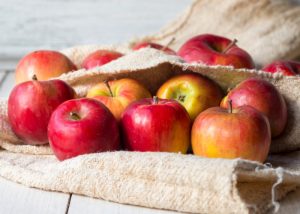
Ingesting prebiotics regularly stimulates the growth and activity of our gut bacteria, which helps aid our digestion.[24] Improved digestion helps food to process through your system to help you lose weight.[25] The additional fiber also helps keep you full and satisfied for longer, as it remains in your intestines for a longer period of time.
Enhance nutrient absorption

Eating prebiotics helps us absorb nutrients better, especially in cases of lactose intolerance, calcium absorption, or constipation.[26] This is also beneficial to elderly people who may not eat sufficient amounts of food or beneficial foods for their needs.
Strengthens immune system

Our gut is constantly exposed to foreign antigens, which are mostly well-tolerated.[27] But when there is an issue, prebiotics help restore our beneficial gut flora and allow them to benefit our bodies.[28] That is, prebiotics help probiotics keep our immune response at the ready to keep us healthy.[29]
Helps regulate glucose levels

Prebiotics help to balance the metabolism and can delay or even reverse metabolic diseases (like diabetes).[30] Resistant starches are especially good for increasing insulin receptivity, which helps contain diabetes and allow diabetics to have more goods days than bad.[31]
Helps with obesity and weight loss

People who eat high-fiber foods tend to weigh less than those of us who consume less fiber.[32] This is because fiber helps you to feel fuller for longer. Americans typically consume about half the recommended amount of fiber each day.[33] Studies have confirmed that those who increased their fiber intake incrementally by 1g consistently showed a weight loss of 0.25g.[34] Inulin is particularly good in this capacity. One study that fed participants two lunches to analyze the effect of inulin on digestion proved that it kept participants fuller longer.[35]
Which Foods are Prebiotic-Rich?
Prebiotics feed healthy bacteria in our bodies, which contributes to good gut health. There are different types of prebiotics, as mentioned above. It is best to consume 5g of prebiotic fiber per day.
However, the important part is whether you will actually take or eat the prebiotics. Information is only good if you actually make use it. So, we have compiled a list of foods that you probably already eat and enjoy that are also prebiotics. Enjoy!
Onions

Onions can be eaten raw or cooked to get their prebiotic benefits. They offer prebiotic fiber content of 2g of fiber per ½ cup. Onions also have a high content of antioxidants, specifically polyphenols (like those in green tea) and have anti-inflammatory effects.[36]
You can try adding some raw onions to a salad. After you dice them, add a squeeze of lemon juice and some salt, and allow them to sit for 10-15 minutes to take the bite off (and the smell!). Of course, you can also add them as a base to any cooked dish, including soups, stews, and casseroles.
Garlic
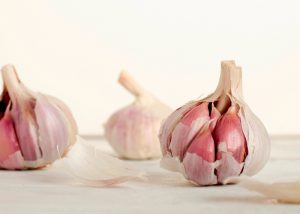
Garlic must be eaten raw to get its prebiotic effect. It offers 2g of prebiotic fiber per ½ cup. Garlic is a known antioxidant which helps to clean our blood. It also helps build the immunity to prevent sickness because it is antifungal, antibacterial, and antiviral.[37]
So, try to avoid taking a garlic supplement for health and consider dicing it very finely to add to guacamole or to a healthy avocado salad dressing. You can also add some chopped garlic to any already-cooked dish to use as a seasoning instead of salt.
Rice

Both whole-grain brown rice and its processed version, white rice, provide prebiotic fiber! Either variety contains 3g of prebiotic resistant starch per ½ cup serving. Rice is gluten-free, and brown rice is also known as a heart-healthy food because it lowers cholesterol and reduces obesity.[38] You can cook rice with anything to add flavor to it, including tomatoes, onions, and celery for a zesty, colorful side dish, or with mushrooms and sliced almonds for a woodsy flair. Or you can add it to a veggie stir-fry.
Barley

Barley isn’t often eaten in the United States, but it can be cooked as an alternate for any grain or pasta. Whole grain barley contains between 3-8g of prebiotic fiber per ½ cup. Barley helps reduce the risk of heart disease and lowers cholesterol in the blood.[39]
Add it to soup or lentils to make them heartier, or you can eat boiled barley with maple syrup in the morning instead of oatmeal.
Oatmeal

Oatmeal for breakfast is heart-warming and heart-healthy! Half a cup contains 2g of prebiotic fiber. Oatmeal, like barley, is known to lower cholesterol and with its viscous fiber content, it takes longer to digest and helps us lose weight.[40] This also improves blood sugar regulation.[41]
Oatmeal is popular for breakfast, but it can also be baked in bread or cookies and can be used as a stuffing.
Apples

Apples with their skins have 2g of prebiotic pectin and fiber per serving. They must be eaten raw in order to preserve their prebiotic power. Apples are high in fiber, antioxidants, and are good for your teeth. They are unusually diverse, and any kind of apple will offer the same benefit. Add apples to your smoothies or salads, or of course, just eat one raw!
Berries
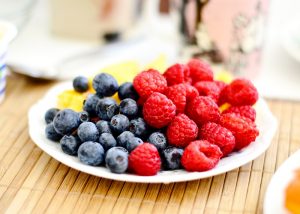
Berries include blackberries, raspberries, blueberries, and elderberries. They must be eaten raw for you to gain their 1g of prebiotic fiber per ½ cup. They are very high in vitamin C and blueberries are a superfood, meaning they boast an extra high amount of antioxidants to keep your cells young and your heart healthy. Berries can be eaten alone, as part of a smoothie, or in a salad.
Black beans/garbanzo beans

Black beans and garbanzo beans have 8g of prebiotic fiber per ½ cup. They also are very high in protein and are a good plant-based substitute for meat. Both black beans and garbanzo beans are used in hummus, which is a paste made with lemon, raw garlic, and olive oil. Or, you can make soup or chili with them, or shape them into patties as a substitute for a burger.
There are also spices, flavorings, and condiments that are prebiotic. These can be combined with any of the above foods for the added prebiotic benefits.
- Raw honey
- Apple cider vinegar
- Ginger
- Seeds (flax, hemp, pumpkin, chia)
- Lemon juice
- Chocolate
Table of Prebiotic Foods
| Prebiotic Foods | Prebiotic Fiber Content |
| Onions | 2g of fiber per ½ cup |
| Garlic | 2g of fiber per ½ cup |
| Rice (white or brown)[42] | 3g of resistant starch per ½ cup |
| Barley | 3-8g per ½ cup |
| Oatmeal | 2g of fiber per ½ cup |
| Apples (with skin) | 2g of fiber per ½ apple |
| Berries | 1g of fiber per ½ cup |
| Black beans and garbanzo beans (including dips and hummus) | 8g resistant starch per ½ cup |
How Many Should I Eat Per Day?
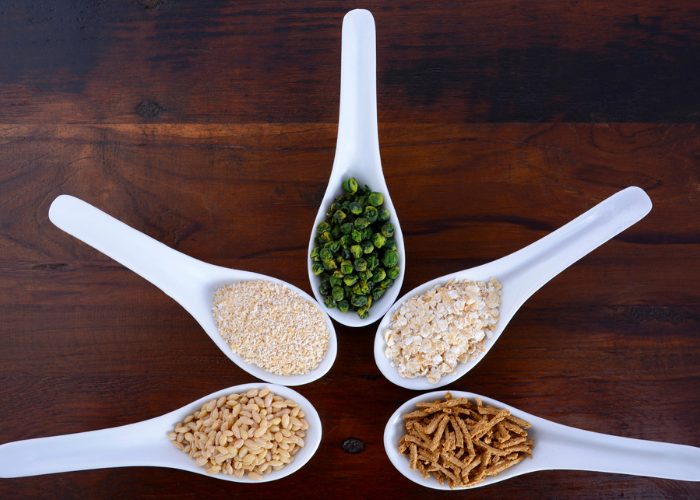
To begin the prebiotic process, we must ingest between 4g and 15g of prebiotic fiber per day.[43] According to recent statistics, American and European diets currently consists of just 3.5g or less of prebiotics per day.
Taking too many prebiotics, or introducing too many too fast, has been known to cause flatulence.[44] At very high levels, 40g or more per day, prebiotics may cause diarrhea.[45] But if we eat too few prebiotics, we may suffer from constipation, abdominal pain, and gas.
The Dietary Guidelines for America Committee for 2010 states that “…though not all dietary fibers are prebiotics, all prebiotics are dietary fibers. Therefore, the recommended intakes of dietary fiber can provide prebiotics to the diet.”[46]
Many of us do an adequate job of eating roughage like wheat bran, which promotes bowel regularity. What we need to eat more of is fermentable fibers such as resistant starches like unripe bananas, grains, and seeds, that support our gut health.
Prebiotic Foods vs. Supplements: Which is Better?

While a goal of consuming 5g of prebiotic fiber per day is not difficult, why worry when you can simply take a supplement?
There are many types of prebiotic powders, capsules, and tablets out there. Some of them are exclusively inulin or FOS powders, while others don’t mention any of the fibrous compounds that make up prebiotics, nor contain any prebiotic food derivatives.
Each supplement will vary in terms of cost and ease of consumption. As well, it takes trial and error to determine if it works well for your specific needs.
However, remember that eating healthy regularly is really what keeps our gut flora in shape. No amounts of supplements will replace a healthy, clean diet of natural fiber provided by fruits and vegetables. Thus, eating natural prebiotics is ideal, but when it’s hard to get a full 5g per day of this specific fiber, consider having a supplement on hand.
Types of prebiotic supplements on the market
- Made from prebiotic foods. The best rated prebiotic supplements are made from prebiotic foods. In this way, you will also get the additional benefits from those foods. For example, the supplement may also help to keep you full if you want to lose weight. Garden of Life offers a prebiotic supplement that is made from five different prebiotic foods.
- Patented formulas. Other prebiotic formulas offer the benefits of gut health with a patented formula instead of food derivatives. The supplements often do not cause bloating or gas that may accompany a new prebiotic regimen. Tobias GutMeister makes a prebiotic-like formula that is patented to kill bad bacteria, to allow good bacteria to thrive. It claims that it causes no gas.
- 2-in-1. Other supplements are more comprehensive and contain both prebiotics and probiotics. They can provide an easy solution for overall better gut health. Genesis Today Superfood Fiber is a powder that includes fiber from a wide array of fruits and vegetables. It boasts antioxidant properties along with prebiotic benefits.
- Prebiotics with added benefits. Additionally, some prebiotic supplements are geared towards women’s health issues. vH supplements contain cranberry extracts to prevent UTIs, as well as additional probiotic support to prevent yeast infections.
- Specific prebiotic compound. There are also prebiotic supplements that are geared towards the specific prebiotic compound, like inulin. Sundown Naturals offers an inulin prebiotic that can be useful if you are trying to lose weight. Gut Garden also has a resistant starch prebiotic if you would like to try it for insulin receptivity.
- Gummies. Lastly, there are prebiotic gummies if you prefer the ease and good taste of a daily supplement in gummy-form. BeLive Probiotic Gummies require very little preparation and have a delicious taste.
How to Add More to Your Diet

Learning to eat a diet that is high in prebiotics is not difficult, nor is it taxing. It requires only an increase of about 2-3g of prebiotic fiber per day to enjoy better gut health. You should aim to consume 4-15g of prebiotic fiber per day.
- Breakfast: Half a cup of oatmeal with half an apple diced with a tablespoon of raw honey adds about 5g of prebiotics to your daily intake.
- Lunch: Whole wheat pita plus half a cup of chickpea hummus (which has raw garlic and lemon juice in it) will give you about 10g of prebiotic fiber in your day.
- Dinner: Half a cup of brown or white rice with a tablespoon of hemp seeds will add about 4g of prebiotics to your diet.
- Snack: One apple or half a cup of berries will add 1-2g of prebiotics to your daily intake! Great!
And, combining your prebiotic meals with a few simple additions of probiotic foods can make your gut happy.
- Breakfast: A cup of yogurt with a few blueberries will add both probiotics and prebiotic fiber.
- Lunch: Have a bowl of miso soup or some tempeh in your sushi for a probiotic-filled meal.
- Dinner: Two forkfuls of sauerkraut or kimchi on the side will add sufficient probiotics for your entire day.
- Snack: One cup of kombucha tea provides probiotics to help balance out your gut bacteria

Conclusion
Helping your gut stay healthy and balanced is not hard to do once you incorporate specific foods into your daily diet. Furthermore, maintaining gut health is a delicious proposition, but so is losing weight, preventing or eliminating cancer, and making diabetes more manageable. Changing a few small parts of your daily meals can make a huge difference in the way you feel. Adding just 5g of prebiotics a day will give your body the gift that keeps on giving: a longer, healthier life.

Share this Image On Your Site
References
- [1] https://www.sciencedirect.com/topics/agricultural-and-biological-sciences/isomaltooligosaccharide
- [2] https://academic.oup.com/jn/article/137/3/830S/4664774
- [3] https://www.ncbi.nlm.nih.gov/pubmed/29027814
- [4] https://www.ncbi.nlm.nih.gov/pmc/articles/PMC6041804/
- [5] https://asbmr.onlinelibrary.wiley.com/doi/full/10.1359/jbmr.2001.16.11.2152
- [6] https://www.ncbi.nlm.nih.gov/pmc/articles/PMC6041804/
- [7] https://www.ncbi.nlm.nih.gov/pmc/articles/PMC6041804/
- [8] https://www.ncbi.nlm.nih.gov/pmc/articles/PMC6041804/
- [9] https://www.ncbi.nlm.nih.gov/pmc/articles/PMC6041804/
- [10] https://www.ncbi.nlm.nih.gov/pmc/articles/PMC6041804/
- [11] https://www.ncbi.nlm.nih.gov/pmc/articles/PMC6041804/
- [12] https://www.ncbi.nlm.nih.gov/pmc/articles/PMC6041804/
- [13] https://www.ncbi.nlm.nih.gov/pmc/articles/PMC6041804/
- [14] https://www.ncbi.nlm.nih.gov/pubmed/9915885
- [15] https://www.ncbi.nlm.nih.gov/pubmed/10655953
- [16] https://www.ncbi.nlm.nih.gov/pmc/articles/PMC3705355/#B5-nutrients-05-01417
- [17] https://www.ncbi.nlm.nih.gov/pmc/articles/PMC3705355/#B5-nutrients-05-01417
- [18] https://www.monash.edu/medicine/ccs/gastroenterology/prebiotic/faq#3
- [19] https://www.eurekalert.org/pub_releases/2013-04/fi-rsc042513.php
- [20] https://www.ncbi.nlm.nih.gov/pmc/articles/PMC5148622/
- [21] https://www.ncbi.nlm.nih.gov/pmc/articles/PMC5148622/
- [22] https://www.ncbi.nlm.nih.gov/pmc/articles/PMC2635701/
- [23] https://www.ncbi.nlm.nih.gov/pmc/articles/PMC2635701/
- [24] https://www.ncbi.nlm.nih.gov/pmc/articles/PMC5622781/
- [25] https://www.ncbi.nlm.nih.gov/pmc/articles/PMC5622781/
- [26] https://www.ncbi.nlm.nih.gov/pmc/articles/PMC1743061/pdf/v080p00447.pdf
- [27] https://journals.lww.com/co-gastroenterology/Abstract/2015/03000/Prebiotics,_probiotics,_synbiotics,_and_the_immune.12.aspx
- [28] https://journals.lww.com/co-gastroenterology/Abstract/2015/03000/Prebiotics,_probiotics,_synbiotics,_and_the_immune.12.aspx
- [29] https://www.ncbi.nlm.nih.gov/pmc/articles/PMC4006993/
- [30] https://www.ncbi.nlm.nih.gov/pmc/articles/PMC3464869/
- [31] https://www.ncbi.nlm.nih.gov/pmc/articles/PMC5298923/
- [32] https://www.ncbi.nlm.nih.gov/pmc/articles/PMC3705355/
- [33] https://www.ncbi.nlm.nih.gov/pmc/articles/PMC3705355/
- [34] https://www.ncbi.nlm.nih.gov/pmc/articles/PMC3705355/
- [35] https://www.ncbi.nlm.nih.gov/pmc/articles/PMC5298923/
- [36] http://www.whfoods.com/genpage.php?tname=foodspice&dbid=45
- [37] http://www.whfoods.com/genpage.php?tname=foodspice&dbid=60#healthbenefits
- [38] http://www.whfoods.com/genpage.php?tname=foodspice&dbid=128#healthbenefits
- [39] http://www.whfoods.com/genpage.php?tname=foodspice&dbid=127#healthbenefits
- [40] http://www.whfoods.com/genpage.php?tname=foodspice&dbid=54
- [41] http://www.whfoods.com/genpage.php?tname=foodspice&dbid=54
- [42] https://www.nutrition.org.uk/nutritionscience/nutrients-food-and-ingredients/resistant-starch.html
- [43] https://www.sciencedirect.com/topics/agricultural-and-biological-sciences/isomaltooligosaccharide
- [44] https://www.ncbi.nlm.nih.gov/pubmed/18215222
- [45] https://www.ncbi.nlm.nih.gov/pubmed/18215222
- [46] https://www.ncbi.nlm.nih.gov/pmc/articles/PMC3705355/








